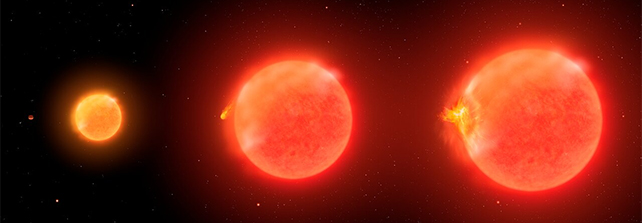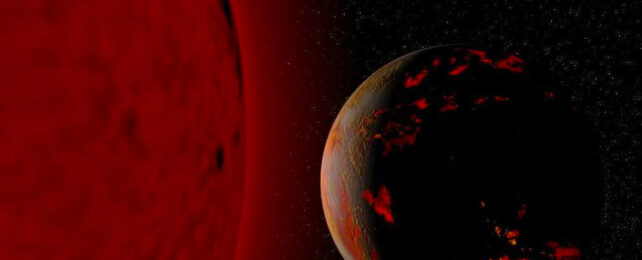For the first time, astronomers have identified the flare of light as a dying star engulfs and destroys one of its orbiting worlds.
Although this phenomenon has long been theorized, finally observing it in action will help astronomers figure out what happens to a planetary system as the star enters its dramatic death throes, puffing up to hundreds of times its original size and swallowing everything in its path, before ejecting its outer material and collapsing down into a hotly glowing stellar remnant.
Previous observations caught the stages just before and just after one of these planetary engulfments, but this is the first time the act has been seen, just 12,000 light-years from Earth. There, a star rapidly increased in brightness by a factor of 100 before rapidly fading, shining with an excess of bright, long-lived infrared light.
This is consistent with models that describe what will happen at the end of the Sun's life and gives information that scientists can use to construct more detailed predictions about the end days for our little corner of the Milky Way galaxy.
"We are seeing the future of the Earth," says astrophysicist Kishalay De of MIT's Kavli Institute for Astrophysics and Space Research. "If some other civilization was observing us from 10,000 light-years away while the Sun was engulfing the Earth, they would see the Sun suddenly brighten as it ejects some material, then form dust around it, before settling back to what it was."
The death of a star like the Sun is a pretty wild process. Observations of other stars in the Milky Way at various stages of their lives have shown us how it plays out.

As the star runs out of hydrogen fuel to burn in its core, the delicate balance between the outward pressure of fusion and the inward pressure of gravity starts to unravel.
The core starts to contract, bringing more hydrogen from the star's outer layers toward the center, concentrating in a shell around the core. Because of the heat and pressure, this hydrogen shell starts to fuse, generating extra heat that puffs the star's outer layers out to up to hundreds of times its original size. But the very outer layers, more tenuous than before, cool towards the redder end of the spectrum. This is what is known as a red giant.
The star will engulf anything in the path of that expanding outer material. Here in the Solar System, this process is expected to take place in a few billion years, with the Sun predicted to expand out as far as Mars's orbit, swallowing Mercury, Venus, and Earth on the way.
De and his colleagues didn't set out looking for a dying star chowing down on its planets. Rather, De was combing through data collected by the Zwicky Transient Facility, which studies the sky in optical and infrared wavelengths, looking for binary stars on such close orbits that one of them slurps material from the other, a process that creates flares of light.
What they actually found was something else entirely.
"One night, I noticed a star that brightened by a factor of 100 over the course of a week, out of nowhere," De says. "It was unlike any stellar outburst I had seen in my life."
A closer look using data from the optical and infrared Keck Observatory to examine the object's chemical composition revealed more strangeness. The star showed signs of elements – such as titanium oxide and vanadium oxide – more consistent with a cool environment, not the hot hydrogen and helium you'd expect from stars swapping plasma.
Further observations with the infrared Palomar Observatory confirmed it. Whatever was going on with the outburst, named ZTF SLRN-2020, it was not a binary star, which meant that the outburst had to be something else.
A look at the scientific literature showed that the way the light bloomed, died, and lingered as cool material glowing infrared was consistent with a type of explosion known as a red nova, the result of a binary star colliding.
But the energy it produced was much, much smaller than you'd expect from a red nova; around a thousandth of the energy, in fact. And that was the final piece of the puzzle.
"That means that whatever merged with the star has to be 1,000 times smaller than any other star we've seen," De says. "And it's a happy coincidence that the mass of Jupiter is about 1/1,000 the mass of the Sun. That's when we realized: This was a planet, crashing into its star."
According to the team's analysis, the planet would have had a maximum mass of about 10 times the mass of Jupiter, being engulfed by and falling towards the core of an expanding red giant.
As the star swallowed the planet, its expanding outer envelope continued to cool, forming a dust cloud around the star that gave the long-term infrared signature observed by the Palomar Observatory.
This, the researchers say, constitutes a "missing link" in our understanding of the evolution of planetary systems. They have named this kind of event "subluminous red novae", and believe that ZTF SLRN-2020 can help us understand the effect planetary engulfment can have on the brightness, chemical composition, and rotation rate of late-stage stars.
They estimate that subluminous red novae occur between 0.1 and several times a year. Now that we know what they can look like, we may find many more.
"For decades, we've been able to see the before and after," De says. "Before, when the planets are still orbiting very close to their star, and after, when a planet has already been engulfed, and the star is giant. What we were missing was catching the star in the act, where you have a planet undergoing this fate in real time. That's what makes this discovery really exciting."
The research has been published in Nature.
